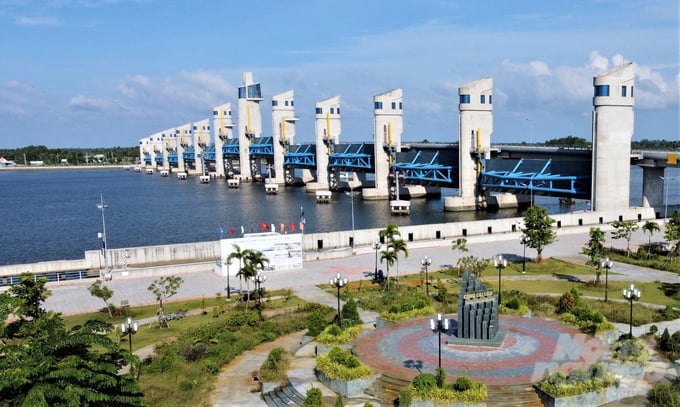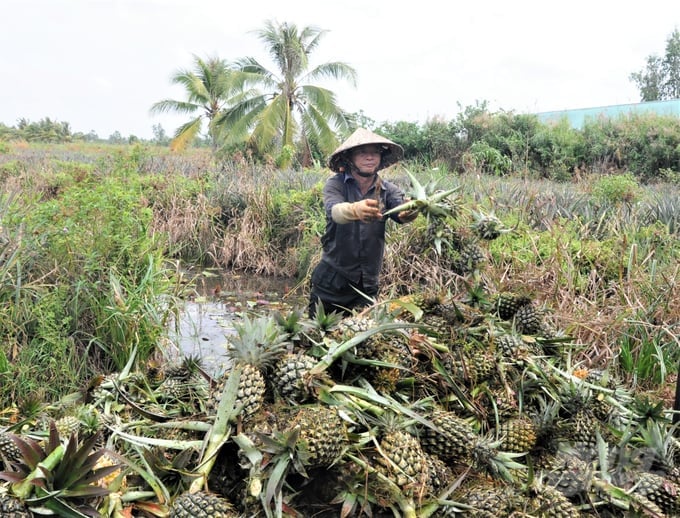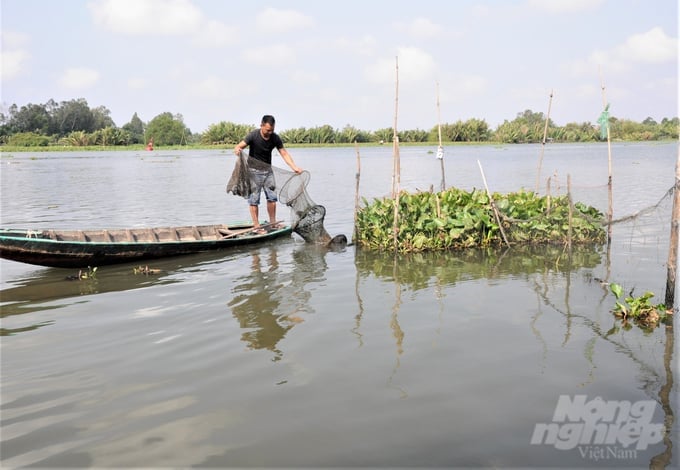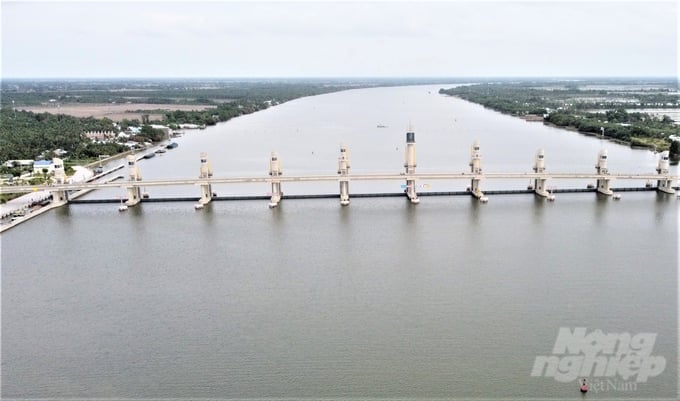May 16, 2025 | 10:39 GMT +7
May 16, 2025 | 10:39 GMT +7
Hotline: 0913.378.918
May 16, 2025 | 10:39 GMT +7
Hotline: 0913.378.918
Editor's note: Amidst the peak of salinity drought in 2024 in the Mekong Delta, the region's sewer system and irrigation works have proven highly effective upon implementation. Reporters from the Vietnam Agriculture Newspaper ventured into the heart of the drought and salinity, capturing firsthand accounts and witnessing remarkable transformations in project areas.
The echo of announcements reverberates across the Cai Lon - Cai Be irrigation system: "Attention all watercraft. We are in the process of operating the sluice gates... Please adhere to signage and instructions." Simultaneously, the hydraulic system gradually lowered 2 Cai Be sluice gates and 11 Cai Lon sluice gates, effectively damming the Cai Be and Cai Lon rivers and staunching the influx of seawater.

Cai Lon Sluice regulates water sources for a large benefit area in 5 provinces. Photo: Trung Chanh.
For four consecutive days (from March 14th to 17th), the entire Cai Lon - Cai Be sluice system remained closed, thwarting the cresting high tides of mid-March. These monumental sluice gates, each weighing hundreds of tons, function akin to colossal barriers, stemming the tide of saline intrusion and orchestrating freshwater distribution to sustain agricultural and economic activities across a sprawling expanse encompassing five provinces: Kien Giang, Hau Giang, Soc Trang, Bac Lieu, and Ca Mau.
Amidst the peak of the dry season and salinity intrusion, I traversed the benefitted regions of the Cai Lon - Cai Be irrigation system, sprawling over an area exceeding 384,120 hectares, predominantly dedicated to rice cultivation, fruit orchards, and aquaculture. Kien Giang emerges as the province with the largest benefitted area, boasting over 247,400 hectares (constituting more than 64% of the total area) across seven districts: Chau Thanh, An Bien, An Minh, U Minh Thuong, Vinh Thuan, Go Quao, and Giong Rieng.
In the benefitted regions overseen by the Kien Giang Department of Agriculture and Rural Development, two rice crops face potential impacts from drought and saltwater intrusion. Firstly, the summer rice crop, spanning 71,570 hectares, has been safely harvested by farmers before saltwater encroachment. Subsequently, these fields are prepared to accommodate brackish water shrimp cultivation in rotation. Secondly, the winter-spring rice crop, encompassing 106,000 hectares, has been harvested since late February and early March.
Mr. Danh Soc, from Dinh Hoa commune, Go Quao district, joyfully expressed, "Despite the early onset of drought this year, thanks to the operation of the irrigation system, sufficient freshwater was available for irrigation until the end of the season. The rice remained uncontaminated by salinity, resulting in plump grains and no stunted growth. The yield reached nearly 8 tons per hectare, fetching a selling price of 7,800 VND per hectare. After deducting expenses, I still yielded a profit of 120 million VND from 3 hectares of rice. In this area, every household is experiencing successful harvests and fetching high prices for their produce."
Moving on to Hau Giang province, benefiting areas encompass Vi Thanh city, Long My town, and the districts of Long My and Vi Thuy. The sown area for the winter-spring crop of 2023-2024 stands at 48,774 hectares, with an accumulated sown area for 2024 exceeding 4,800 hectares. Furthermore, various fruit orchards occupy approximately 12,500 hectares, alongside 475 hectares designated for aquaculture.

The Cai Lon - Cai Be irrigation system operates effectively, safely protecting the benefit area spread over an area of more than 384,120 hectares. Photo: Trung Chanh.
Mr. Ngo Van Leo, residing in Hoa Tien commune, Vi Thanh city, and cultivating over 1 hectare of pineapples, noted that salinity intrusion from the Cai Lon river has persisted in the area for approximately a month. However, the salinity levels this year are relatively moderate. Meanwhile, with the sluice gates closed to prevent salinity, farmers are capitalizing on the opportunity to channel fresh water into their pineapple gardens, constructing dams to safeguard their crops.
Mr. Leo emphasizes that the land along the Cai Lon river in Hoa Tien commune is not conducive to rice cultivation, but pineapples thrive exceptionally well. Pineapple trees are ideally suited to alkaline soil and exhibit robust drought tolerance. They require minimal watering during the dry season, with the primary necessity being to maintain fresh water in the ditches to keep the roots moist and facilitate pineapple transportation during harvesting. Mr. Leo recently completed harvesting the main crop of pineapples a few days ago. Presently, pineapple prices are soaring, reaching 12,000 VND per type I fruit (weighing 1 kg or more). Farmers can cultivate multiple batches of pineapples throughout the year in their gardens, harvesting approximately 15,000 to 20,000 fruits. The profits derived from growing pineapples far exceed those from rice cultivation.

In the midst of the drought and salinity, the pineapple area of farmer Ngo Van Leo\'s household (Hoa Tien commune, Vi Thanh city) is still protected and safe. Photo: Trung Chanh.
Adjacent to the Kenh Lau sluice gate, which connects to the Cai Lon River in Hoa Tien commune, Mr. Nguyen Chi Phong is intimately familiar with the annual occurrence of saltwater intrusion during the dry season. Mr. Phong remarks, "Merely by observing the water's color transition from silvery (indicative of alluvial water) to clear blue or witnessing the wilting of water hyacinth in the river, I can gauge the extent of saline intrusion. This year, salinity arrived early, but thanks to the operation of the Cai Lon - Cai Be public system, salinity levels did not escalate significantly."
Residing along the river, Mr. Phong has installed traps in the river to catch shrimp and wild fish, alongside setting up a trap to rear red tilapia beneath the flooring. Initially, when saltwater infiltrated the river, the family's farmed fish refrained from eating for a few days due to water shock. However, they gradually acclimated and resumed normal feeding behavior. Fortunately, the fish continue to thrive without harm due to the moderate salinity levels.
The Cai Lon - Cai Be irrigation system comprises the Cai Lon, Cai Be, and Xeo Ro sluice clusters, entrusted by the Ministry of Agriculture and Rural Development to the Southern Irrigation Company Limited for management and operation. Given that these works affect inter-provincial benefitted areas, coordination with localities is imperative to regulate freshwater, saline, and brackish water sources, catering to agricultural production and the economic well-being of the populace.
Mr. Le Tu Do, Director of the Mekong Delta Branch of Southern Irrigation Company Limited, disclosed that in 2023, the company issued 16 operational plans for the Cai Lon, Cai Be, and Xeo Ro sluice clusters in accordance with regulations. The temporary operation of the Cai Lon - Cai Be irrigation system was mandated by the Ministry of Agriculture and Rural Development. Notably, three training exercises were conducted (in May, September, and December 2023) to simulate natural disaster scenarios and operational situations at the Cai Lon and Cai Be sluice clusters, as well as the Xeo boat locks.

Freshwater fish can still live near the Kenh Lau sluice gate connecting to the Cai Lon River in Hoa Tien commune, Vi Thanh city despite the peak of saline drought. Photo: Trung Chanh.
Throughout the operation, the Company maintained close coordination with institutes, specialized agencies, and Departments of Agriculture and Rural Development in benefitted areas, formulating plans aligned with production schedules and seasonal dynamics. Emphasis was placed on water resource development and water quality management in the sewer system area, ensuring optimal service for agricultural production, aquaculture, and community livelihoods. This operational process also enhanced the capacity and professionalism of officials and employees, enabling an effective response to construction incidents and contributing to efficient natural disaster prevention and control efforts.
According to forecasts, the dry season of 2023-2024 is expected to witness higher-than-average salinity levels in the Cai Lon and Cai Be rivers. The peak salinity is anticipated in March-April 2024, possibly extending into late months. Along the Cai Lon river, salinity levels of 4‰ (g/l) could penetrate 45-47 kilometers deep, while salinity of 1‰ may reach depths of 55-57 kilometers (at Cai Tu bridge). Similarly, along the Cai Be river, salinity of 4‰ could permeate 25 kilometers deep (in Long Thanh commune, Giong Rieng district), with salinity of 1‰ reaching depths of 30 kilometers (near Long Thanh bridge). Saltwater intrusion intensifies during high tide days.

Cai Lon sluice is operated to prevent the tide in mid-March, preventing salt water from the sea from encroaching deep into the field. Photo: Trung Chanh.
In response to this scenario, Southern Irrigation Company Limited has closely collaborated with management units, irrigation operators, and local authorities in benefitted areas to leverage the operation of the Cai Lon - Cai Be irrigation system. This includes mitigating tidal peaks, ensuring effective control and regulation of water resources, maintaining freshwater sources, and managing river salinity levels at reasonable thresholds to support production activities, particularly in brackish water shrimp farming.
In 2023, the Cai Lon - Cai Be irrigation system operated effectively, regulating water sources to facilitate secure production across freshwater, brackish, and saline ecological models. The total rice cultivation area 2023 encompassed 708,942 hectares, comprising seasonal crops (rice on shrimp-rice land), winter-spring, summer-autumn, and autumn-winter crops, with an estimated harvest of nearly 4.5 million tons. Aquaculture covered approximately 302,000 hectares, with shrimp farming occupying about 166,000 hectares and the remainder allocated to fish and other aquatic products, yielding an estimated output of 275,000 tons, with shrimp farming alone contributing 99,000 tons.
Translated by Quynh Chi

(VAN) Cold-barn systems efficiently manage environmental and temperature conditions, which aids in the prevention of respiratory diseases in pigs and protects them from the vectors that transmit African swine fevers.

(VAN) To tackle challenges, the project 'Addressing key technical bottlenecks in the grouper supply chain in Vietnam' has been underway since 2024.

(VAN) The project 'Disease-Resilient and Sustainable Cassava Production Systems in the Mekong Region', funded by the Australian Center for International Agricultural Research (ACIAR), is being implemented from 2024 to 2028.

(VAN) Data from 10,000 farming households will help professionalize production organization and support the implementation of the One Million Hectares Program for High-Quality, Low-Emission Rice Cultivation.

(VAN) FAO Director-General QU Dongyu marks International Day of Plant Health at NENA conference.

(VAN) Deputy Minister of Agriculture and Environment Hoang Trung affirmed that floriculture and ornamental plants are a growing industry that receives significant global attention.

(VAN) The three staple crops dominating modern diets – corn, rice and wheat – are familiar to Americans. However, fourth place is held by a dark horse: cassava.